Introduction to Marketing Funnel
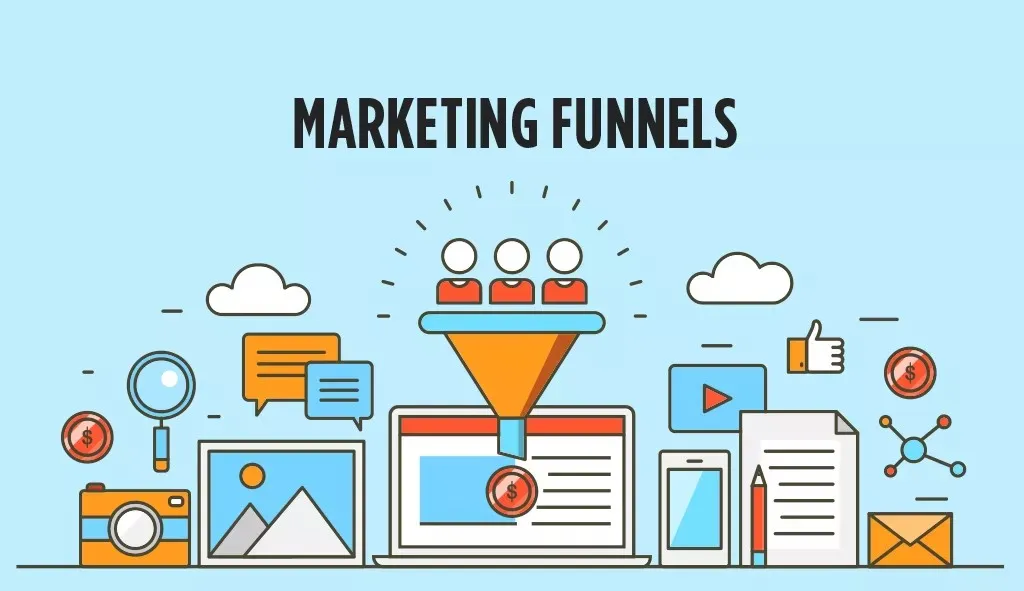
What Is a Marketing Funnel
A marketing funnel is a strategic model that depicts the journey of a potential customer from the initial stage of awareness to the final stage of making a purchase and beyond. This concept helps businesses understand and leverage the process to convert prospects into loyal customers.
Overview of Marketing Funnel Stages
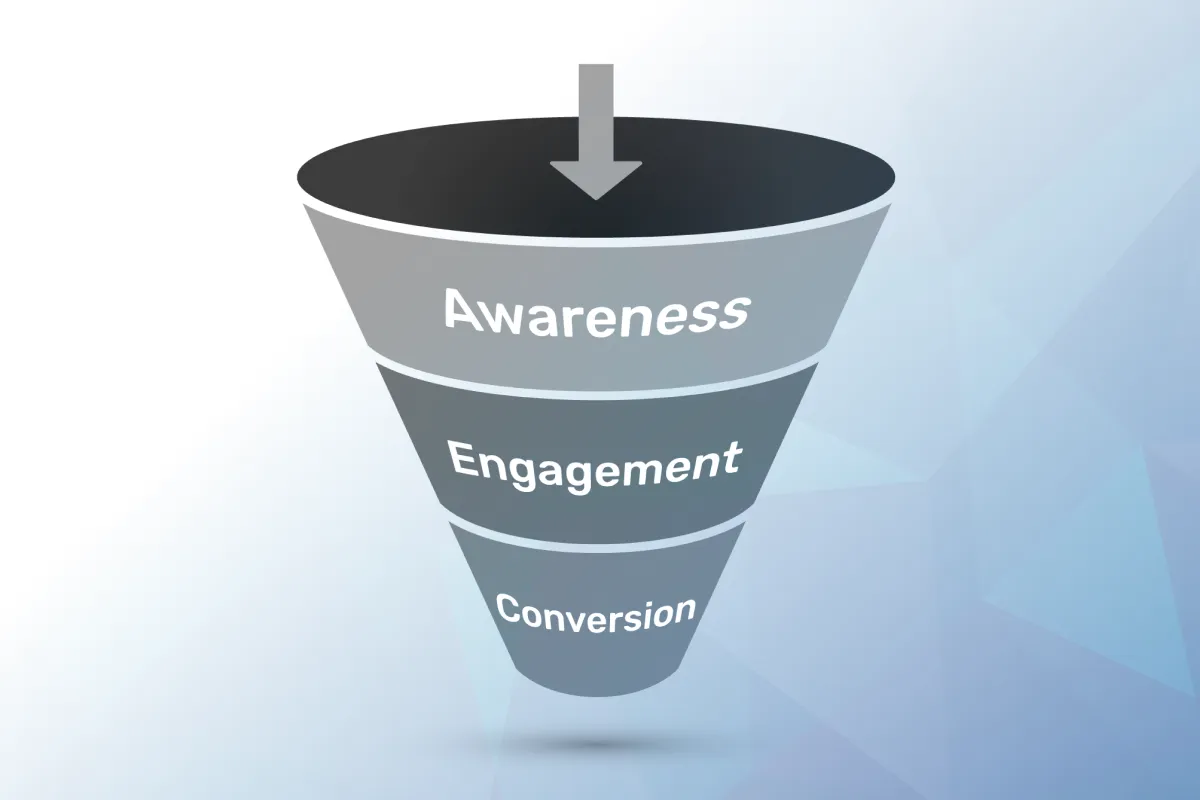
1. Awareness Stage
The top-of-funnel, stage where potential customers first learn about a brand or product.
Studies show that 81% of consumers conduct research online before making a purchase, highlighting the importance of a strong digital presence.
2. Consideration Stage
The middle-of-funnel, Prospects evaluate the offered product or service against their needs and other market options.
According to HubSpot, personalized calls-to-action have a 42% higher view-to-submission rate than generic CTAs, underscoring the need for targeted content in this stage.
3. Conversion Stage
The bottom-of-funnel, final decision to make a purchase is made here.
E-commerce sites can increase conversions by 35% through better checkout design, as per a Baymard Institute report.
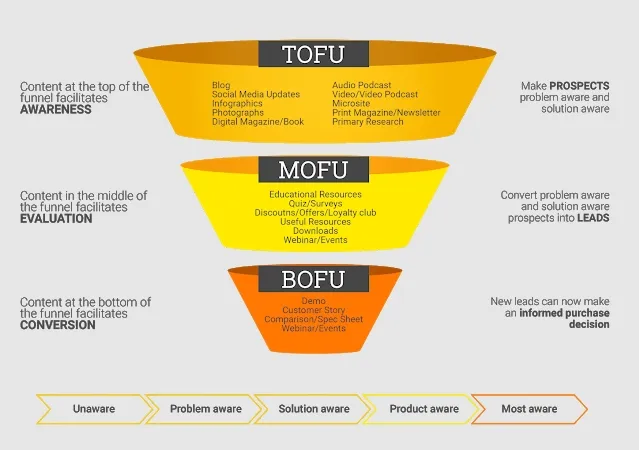
Marketing Funnel Models
Marketing funnel models are foundational to creating effective, customer-centric marketing strategies. They offer a systematic approach to understanding and influencing the customer journey, driving better marketing outcomes through targeted engagement, measurement, and continuous optimization.
By leveraging these models, businesses can more effectively guide potential customers from initial awareness to loyal advocacy, maximizing both customer value and business growth.
1. AIDA Model

- Awareness: The customer becomes aware of a product or service.
- Interest: They show interest in a category of products.
- Desire: The customer starts to show a specific preference.
- Action: Finally, they perform a purchasing action.
2. The RACE Planning Framework
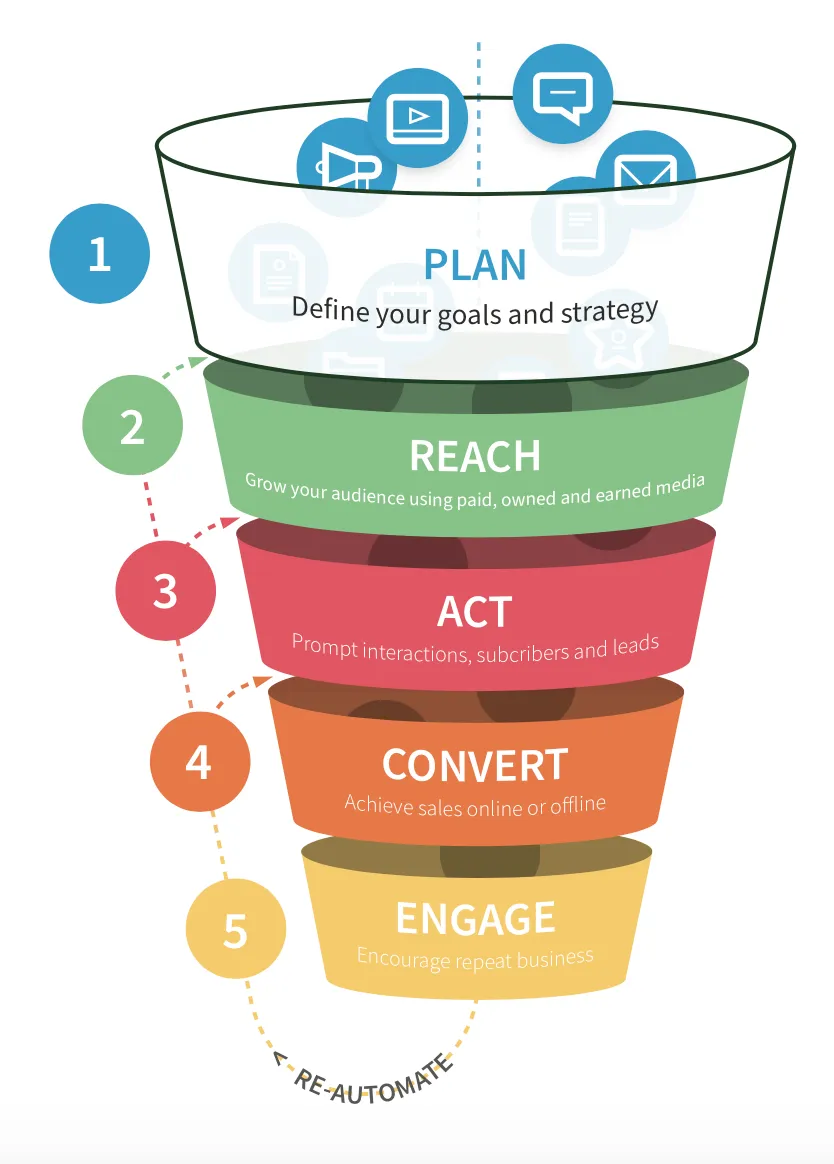
- Reach: Building awareness and visibility.
- Act: Encouraging interactions to lead to a conversion.
- Convert: Transforming interactions into valuable actions.
- Engage: Developing long-term relationships that encourage repeat transactions.
3. The Conversion Funnel Model

- Attention: Grabbing the attention of the potential customer.
- Interest: Keeping their interest focused on the message.
- Desire: Creating a desire for the product or service.
- Action: Leading towards taking action, such as making a purchase.
4. The Flywheel Model

Instead of a traditional funnel, the flywheel model focuses on the momentum of engaged customers to attract and engage others. It includes:
- Attract: Drawing in the right prospects.
- Engage: Offering solutions that solve problems.
- Delight: Providing an outstanding experience that creates advocates.
5. The Loyalty Loop

Moving beyond the initial sale, this model emphasizes creating a loop where customers return and advocate for the brand, through:
- Experience: Delivering an excellent customer experience.
- Loyalty: Building loyalty through continued engagement.
- Advocacy: Encouraging satisfied customers to share their experiences.
6. The Pirate Funnel (AARRR)

- Acquisition: Users come to the site from various channels.
- Activation: Users enjoy their first visit.
- Retention: Users keep coming back.
- Revenue: Users conduct some monetization behavior.
- Referral: Users refer others.
Understanding Top of the Funnel Marketing to Build a Funnel
Understanding the Top of the Funnel (ToFu) stage is crucial for businesses looking to build an effective marketing funnel that captures and nurtures potential customers from their first interaction with the brand.
This marketing funnel stage focuses on awareness and engagement, setting the groundwork for further interactions that lead down the funnel towards conversion.
What is Top of the Funnel Marketing?
ToFu marketing aims to attract a broad audience, introducing them to your brand without a hard sell. It's about creating initial awareness, sparking interest, and laying the foundation for a relationship.
Purpose: The primary goal is to turn strangers into visitors and leads by providing valuable content and information that addresses their needs or interests.
Why Top of the Funnel Marketing Matters
Building Awareness: Consumers are bombarded with information. Effective ToFu marketing cuts through the noise, making your brand known to potential customers.
- According to Google, 53% of shoppers say they always do research before they buy to ensure they are making the best possible choice. This underscores the importance of being visible and valuable at the top of the funnel.
Educating Potential Customers: By providing educational content, you position your brand as a thought leader and a trustworthy source of information.
- Potential customers at this stage are not yet ready to buy; they're gathering information to solve a problem or meet a need.
How to Implement Top of the Funnel Marketing
Content Development: Craft top-notch, insightful material that caters to the preferences and requirements of your intended audience.
- Blog posts, infographics, and videos that answer common questions or provide insights can attract a wide audience.
- Use awareness stage content to address general topics related to your industry, not just your specific products or services.
SEO Strategy: Optimize all ToFu content with relevant keywords to ensure visibility in search engine results.
Social Media Engagement: Utilize social media platforms to share your ToFu content widely, engaging with users to build brand recognition.
- Platforms like Facebook, Instagram, and Twitter allow for the broad dissemination of social media posts, expanding your reach.
Analytics and Optimization: Monitor the performance of your ToFu activities with tools like Google Analytics.
- Tracking website traffic and engagement metrics provides insights into what content resonates with your audience, allowing for continual refinement of your strategy.
Building a Funnel with Top of the Funnel Marketing
The journey doesn’t end with creating awareness. ToFu marketing should seamlessly connect to the middle of the funnel (MoFu), where deeper engagement happens, and the bottom of the funnel (BoFu), where conversion occurs.
Lead Capture: Encourage visitors to sign up for newsletters or download free resources in exchange for their contact information.
- This customer journey progression requires content that adds enough value to merit a trade of information, effectively turning visitors into leads.
Nurturing Leads: With a focus on marketing campaigns, use email marketing and targeted content to gently guide leads through the funnel, providing more specific information and solutions as they show increased interest.
Understanding Middle of the Funnel Marketing to Build a Funnel
Understanding the Middle of the Funnel (MoFu) marketing is crucial for businesses aiming to nurture their leads toward making a purchase decision. This stage serves as a bridge between creating initial awareness at the top of the funnel and converting leads into customers at the bottom.
MoFu marketing focuses on engaging your prospects more deeply, providing them with the information and reassurance they need to consider your offerings as viable solutions to their problems.
Definition and Purpose of Middle of the Funnel Marketing
MoFu marketing targets potential customers who are already aware of their problem and are considering various solutions. The goal is to:
- Educate and provide in-depth information that showcases the value of your solutions.
- Establish trust and credibility, positioning your brand as the preferred choice.
Why Middle of the Funnel Marketing Matters
- Nurturing Leads: Leads at this stage are interested but not yet ready to buy. Effective MoFu marketing strategies can move these leads closer to a purchasing decision.
- Building Relationships: By engaging leads with relevant and useful content, you deepen the relationship, increasing the likelihood of conversion.
How to Implement Middle of the Funnel Marketing
Content Marketing: Create and share content that addresses specific questions or concerns your prospects might have.
- Use case studies, eBooks, and whitepapers to demonstrate the effectiveness of your solutions.
- Webinars and product demos can provide a deeper look into how your products or services work, offering valuable insights to your prospects.
Email Marketing: Personalized email campaigns can be very effective in MoFu marketing.
- Segment your email list based on the interests and behaviors of your leads to provide them with the most relevant content.
- Consider sending a series of educational emails that guide leads through key considerations and decision-making criteria related to your offerings.
Lead Scoring: Implement a lead scoring system to identify the most engaged and sales-ready leads.
- This process involves assigning values to each lead based on their engagement level and interest in your content, helping prioritize follow-up efforts.
Building a Funnel with Middle of the Funnel Marketing
Transitioning leads from MoFu to the bottom of the funnel (BoFu) requires a clear understanding of your audience’s needs and the ability to present your marketing tactics as the best answer to those who needs.
Call to Action (CTA): Ensure that your MoFu content includes clear, compelling CTAs that guide leads to the next step, whether it's scheduling a consultation, signing up for a free trial, or viewing a product demonstration.
Feedback and Surveys: Collect feedback through surveys or direct engagement to better understand the remaining concerns or questions leads may have. This information can help refine your MoFu strategy, loyalty programs, and content to better meet the needs of your audience.
Analytics and Adjustment: Use analytics tools to track the performance of your MoFu strategies. Look at metrics such as engagement rates, time spent on content, and conversion rates to identify what’s working and where improvements can be made.
Integration with Sales: Ensure there is a smooth handoff process from marketing to sales. The insights gathered during the MoFu stage can provide valuable information to sales teams, allowing for more personalized and effective sales conversations and marketing qualified leads.
Understanding Bottom of the Funnel Marketing to Build a Funnel
Understanding Bottom of the Funnel (BoFu) marketing is essential for businesses aiming to convert their well-nurtured leads into paying customers. This stage is crucial because it focuses on prospects who have shown a clear interest in your product or service and are on the verge of making a purchase decision.
BoFu marketing involves providing the final nudge to encourage that decision, leveraging detailed, persuasive content, and personalized engagement strategies.
The Importance of Bottom of the Funnel Marketing
At the bottom of the funnel, your marketing efforts need to be highly targeted and conversion-focused. The prospects at this stage:
- Have already recognized their need or problem and considered your solution as a viable option.
- Require clear, compelling reasons to choose your solution over competitors’.
Effective BoFu Marketing Strategies
Personalized Demos and Consultations
Offering one-on-one demos or consultations can address specific questions or concerns that the prospect might have, providing a tailored experience that highlights the value of your solution.
For B2B companies, personalized demos have been shown to significantly increase conversion rates, as they directly address the prospect's unique needs.
Customer Testimonials and Case Studies
Sharing success stories and positive outcomes from current customers can alleviate last-minute hesitations by showcasing real-world applications and benefits.
Including statistics or measurable results in case studies can further validate the effectiveness of your product or service.
Special Offers and Incentives
Exclusive discounts or time-limited offers can create a sense of urgency, encouraging prospects to act.
A study found that limited-time offers can increase sales by up to 33%, highlighting the power of urgency in influencing purchase decisions.
Streamlined Checkout Process
Simplifying the purchasing process can remove barriers to conversion, making it as easy as possible for the prospect to complete their purchase.
Optimizing the checkout process, including multiple payment options, and offering clear, concise instructions can reduce cart abandonment rates.
Building a Funnel with Bottom of the Funnel Marketing
Transitioning leads from consideration to purchase requires not just persuasive content but also an understanding of the nuances that influence the final decision. Here’s how to effectively leverage BoFu marketing:
Clear and Compelling Calls to Action (CTA): Ensure that your CTAs are direct, offering clear next steps whether it's making a purchase, signing up, or contacting sales.
Follow-Up Strategies: Implement follow-up strategies for prospects who have shown high interest but have not yet made a purchase. This could involve personalized emails or retargeting ads.
Measurement and Optimization: Use analytics tools to measure the effectiveness of your BoFu marketing efforts. Look at conversion rates, average deal size, and sales cycle length to identify areas for improvement.
Feedback Loop: Establish a feedback loop with your sales team to gain insights into the common questions, concerns, and objections that prospects have at this stage. Use this information to refine your BoFu content and strategies.
Marketing Funnel Metrics
Marketing funnel metrics provide insights into how well a marketing funnel is converting prospects into customers and identify areas that need improvement.
Understanding and monitoring these metrics is essential for optimizing marketing strategies and achieving better ROI.
Key Marketing Funnel Metrics
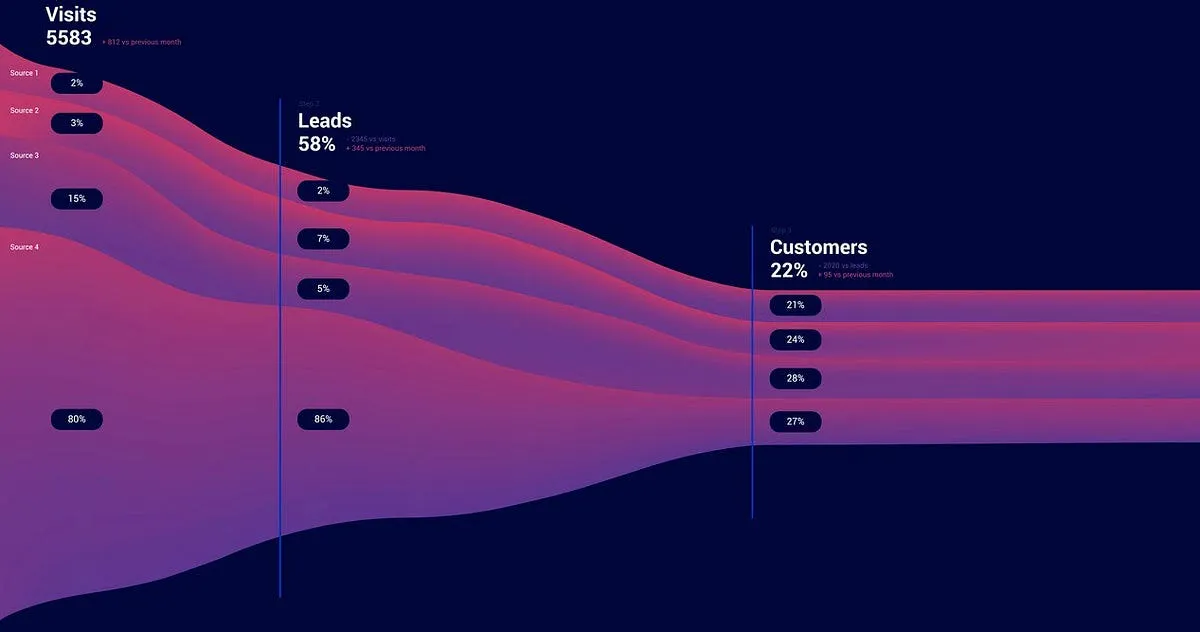
Conversion Rates: Measures the percentage of prospects moving from one stage of the funnel to the next.
- It indicates the effectiveness of your marketing efforts at each stage, helping identify bottlenecks.
- Improve content or strategies at stages with low conversion rates to enhance overall funnel performance.
Lead Acquisition Cost: The cost associated with acquiring a new lead.
- It helps gauge the efficiency of your marketing spend.
- Compare against the customer lifetime value to ensure sustainable marketing practices.
Customer Lifetime Value (CLV): The total revenue a business can expect from a single customer account.
- It's essential for determining how much to invest in acquiring new customers and retaining existing ones.
- Increase focus on retention strategies if CLV is significantly higher than acquisition costs.
Bounce Rate: The percentage of visitors who navigate away from the site after viewing only one page.
- High bounce rates can indicate that your landing pages are not engaging or relevant to your target audience.
- Optimize landing page content and design to make it more appealing and relevant.
Average Order Value (AOV): The average amount spent each time a customer makes a purchase.
- It helps measure the value of each transaction and identify opportunities to increase sales.
- Implement upselling and cross-selling strategies to boost AOV.
Retention Rate: The percentage of customers who continue to buy from a business over a given period.
- It measures customer loyalty and the effectiveness of retention marketing strategies.
- Enhance customer experience and implement loyalty programs to improve retention.
Net Promoter Score (NPS): A measure of customer satisfaction and loyalty.
- It provides insights into customer loyalty and predicts business growth.
- Follow up with detractors to resolve issues and improve the product or service based on feedback.
The Marketing Funnel vs. the Marketing Flywhee

Different Types of Marketing Funnels
Marketing funnels have evolved to accommodate different customer behaviors and strategic marketing approaches. Here’s a breakdown of various types of marketing funnels, highlighting their unique characteristics and applications:
1. Traditional Marketing Funnel
- Characteristics: Linear progression through Awareness, Interest, Desire, and Action (AIDA).
- Application: Best for straightforward purchasing processes where customers follow a predictable path from learning about a product to making a purchase.
2. Sales Funnel
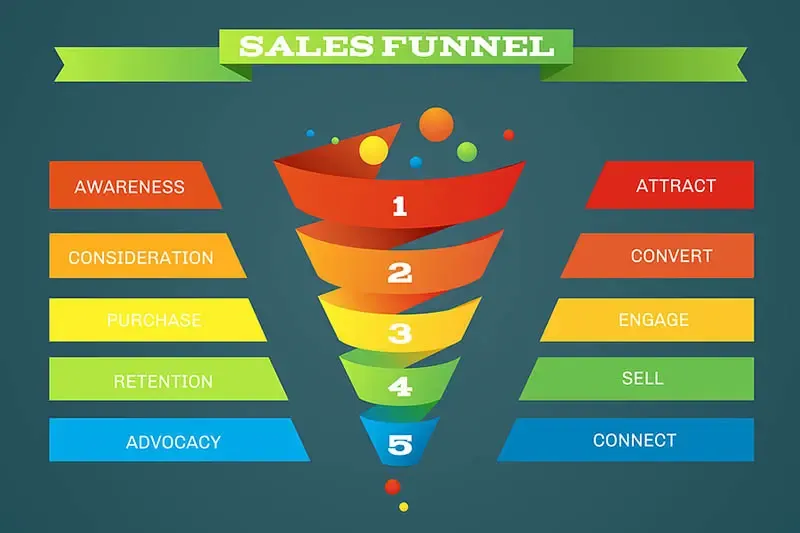
- Characteristics: Similar to the traditional marketing funnel but with a greater focus on the sales process, including stages like Evaluation and Purchase.
- Application: Ideal for businesses with a dedicated sales team that closely guides the customer through the buying process.
3. Content Marketing Funnel
- Characteristics: Utilizes content at each stage to attract, engage, and convert. Stages are often tailored around the types of content that work best, from educational blogs at the top to product demos at the bottom.
- Application: Effective for businesses aiming to establish thought leadership and nurture leads with valuable information over time.
4. Digital Marketing Funnel
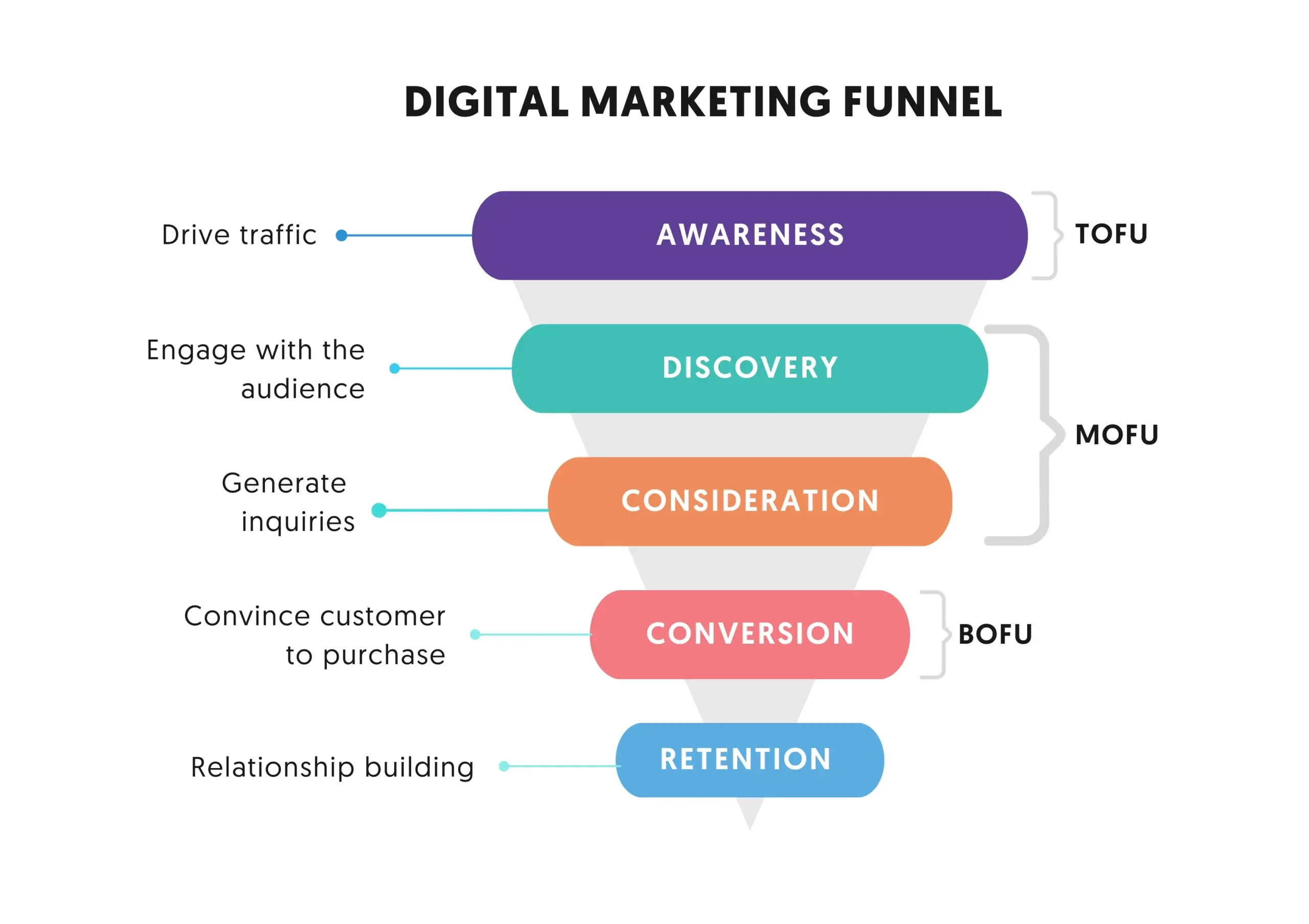
- Characteristics: Adapts the traditional funnel concept to digital interactions, emphasizing online behaviors from social media engagement to online purchases.
- Application: Suitable for businesses with a strong online presence, leveraging digital channels for lead generation and conversion.
5. Conversion Funnel
- Characteristics: Highly focused on optimizing conversion rates at each stage, often leveraging A/B testing and user experience (UX) improvements to increase effectiveness.
- Application: Best for e-commerce and online businesses focused on maximizing the efficiency of website and landing page visitors turning into customers.
6. Email Marketing Funnel
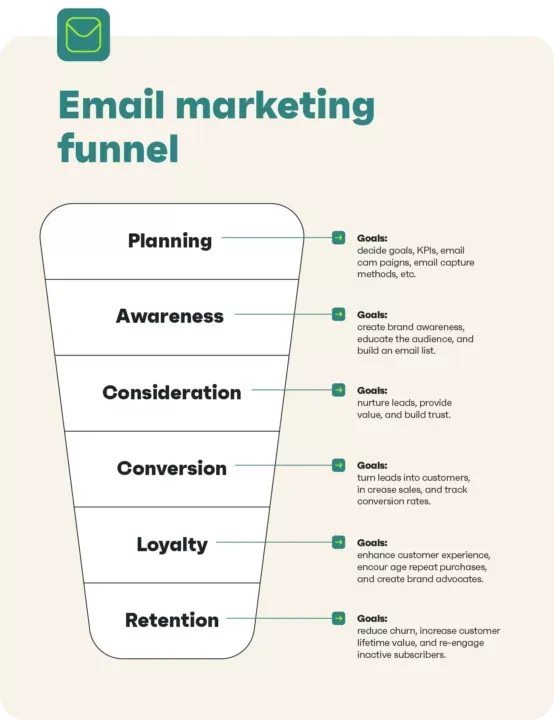
- Characteristics: Uses email as the primary tool to move leads through the funnel, from subscription and nurturing emails to promotional offers and post-purchase follow-ups.
- Application: Effective for businesses that rely on building and maintaining direct relationships with their audience through email communication.
7. Social Media Marketing Funnel
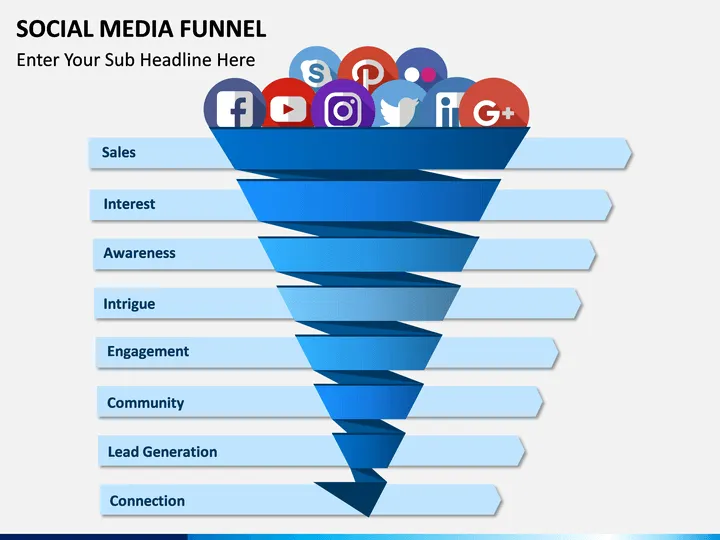
- Characteristics: Tailored around engaging users on social media platforms, converting them into leads or customers through targeted ads, content sharing, and community building.
- Application: Ideal for brands that engage customers where they spend a significant amount of time online, fostering community and leveraging social proof.
8. Video Marketing Funnel
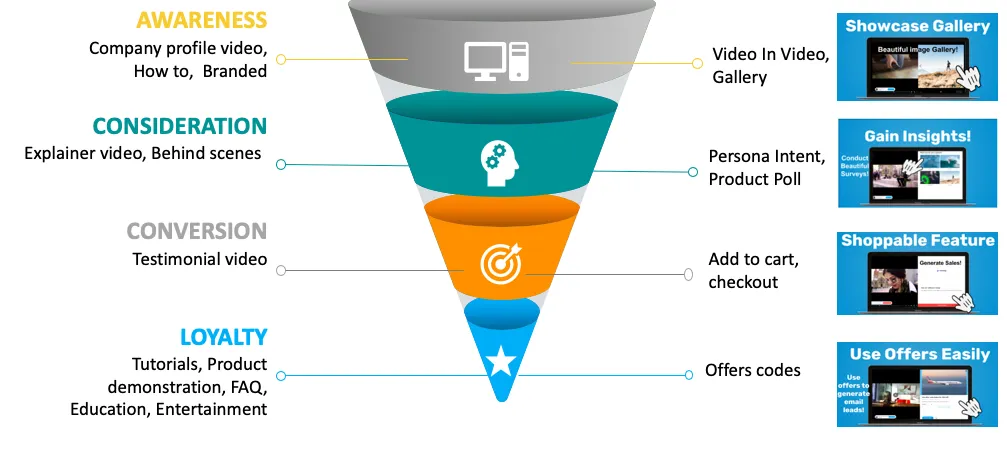
- Characteristics: Leverages video content at every stage, from brand awareness through explainer videos to customer testimonials and product demos for conversion.
- Application: Suitable for businesses looking to capitalize on the high engagement and conversion rates associated with video content.
What is the Difference Between Marketing and Sales Funnel

How to Build a Marketing Funnel

Building a successful marketing funnel is a strategic process that involves understanding your audience, creating targeted content, and leveraging various digital tools to guide potential customers through their buying journey.
A well-constructed funnel not only attracts leads but also nurtures them into loyal customers. Here’s an in-depth guide on how to achieve this:
1. Define Your Target Audience
Understanding who your potential customers are is the first step in building an effective marketing funnel.
- Conduct market research to gather insights about your audience's demographics, preferences, and pain points.
- Use analytics tools to analyze website and social media data, helping identify your most engaged segments.
2. Map Out the Customer Journey
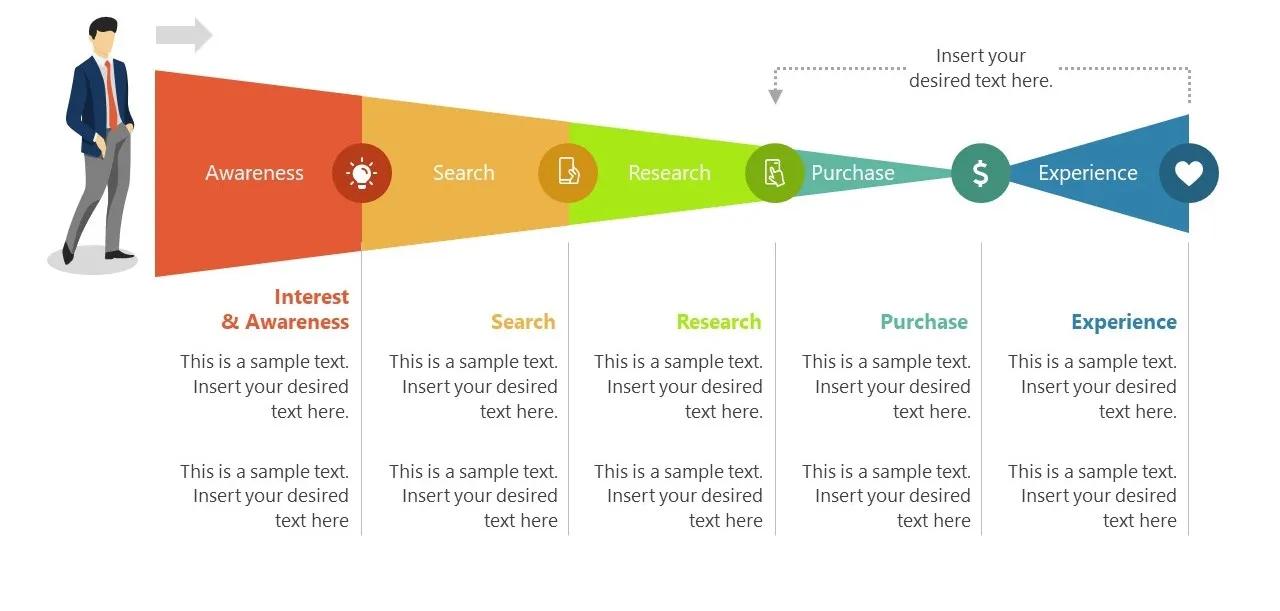
The customer journey outlines the path prospects take from becoming aware of your brand to making a purchase.
- Break down the journey into key stages: Awareness, Consideration, Decision, and Loyalty.
- Identify the objectives and challenges at each stage, which will inform the type of content and interactions you create.
3. Create Valuable Content

Content is what attracts and engages your audience through each funnel stage.
- Awareness: Use blog posts, videos, and social media to educate your audience about their pain points.
- Consideration: Offer in-depth content like webinars, e-books, and case studies that showcase your solutions.
- Decision: Provide testimonials, product comparisons, and free trials to help prospects make a decision.
- Loyalty: Send personalized emails, offer exclusive deals, and solicit feedback to keep customers engaged.
4. Optimize Lead Generation Tactics
Capturing lead information allows you to nurture them through the funnel.
- Create compelling lead magnets such as free guides, checklists, or course trials that require users to submit their contact information.
- Design landing pages specifically for these offers, ensuring they are optimized for conversion with clear calls-to-action (CTAs).
5. Implement Lead Nurturing Strategies
Once you have leads, you need to nurture them towards a purchase.
- Develop segmented email marketing campaigns that deliver personalized messages based on the lead's stage in the funnel.
- Utilize retargeting ads to stay top of mind with prospects who have engaged with your content but haven't converted.
6. Leverage Automation and Personalization
Marketing automation tools can significantly enhance the efficiency and effectiveness of your funnel.
- Use automation to trigger specific emails based on actions that users take, ensuring timely and relevant follow-up.
- Personalize the user experience as much as possible, from customized email greetings to tailored content recommendations.
7. Analyze and Optimize Your Funnel
Constant analysis is key to understanding what’s working and what isn’t in your funnel.
- Track key performance indicators (KPIs) such as conversion rates, bounce rates, and customer acquisition cost at each stage of the funnel.
- Regularly review and adjust your strategies based on analytics insights. A/B testing can be particularly effective in optimizing landing pages, emails, and CTAs for better performance.
8. Encourage Advocacy and Referrals
Turn your satisfied customers into brand advocates.
- Implement referral programs that incentivize customers to refer friends and family.
- Encourage reviews and social shares to leverage word-of-mouth marketing.
How to Optimize Each Stage of the Funnel
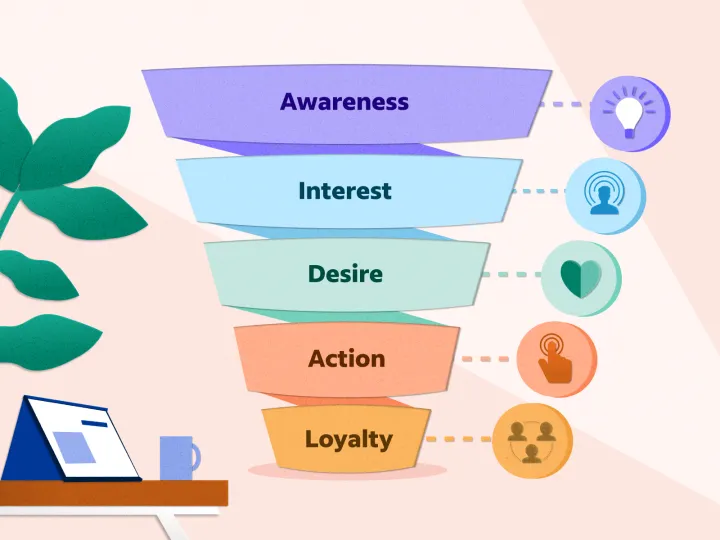
Optimizing each stage of the marketing funnel is essential for converting prospects into loyal customers efficiently. Here's an in-depth look at different marketing strategy to maximize the effectiveness of each funnel stage:
1. Awareness Stage
Objective: Make potential customers aware of your solutions.
- Content Marketing: Produce high-quality, educational content that addresses the audience's pain points and interests. Blogs, infographics, and videos can boost organic search visibility, driving top-of-funnel traffic.
- SEO: Optimize all content with relevant keywords to rank higher in search engine results, making it easier for your target audience to find you.
- Social Media: Leverage platforms where your target audience spends their time to increase brand visibility and engagement.
2. Consideration Stage
Objective: Help prospects evaluate your offerings as potential solutions.
- Email Marketing: Send targeted content that addresses specific interests or concerns, nudging leads further down the funnel.
- Targeted Landing Pages: Create landing pages that provide more detailed information about your products or services, tailored to the interests of prospects at this stage.
- Case Studies and Webinars: Showcase the value of your solutions through real-world examples and in-depth discussions.
3. Decision Stage
Objective: Encourage leads to choose your solution.
- Free Trials/Demos: Offer a risk-free way to experience your product or service firsthand
- Customer Testimonials and Reviews: Build trust and credibility by highlighting positive experiences from existing customers.
- Personalized Offers: Send tailored promotions or discounts to leads showing high intent but who may need an extra nudge to convert.
4. Loyalty Stage
Objective: Turn new customers into repeat buyers and brand advocates.
- Onboarding Emails: Welcome new customers with a series of emails that help them get the most out of their purchase.
- Loyalty Programs: Reward repeat purchases with discounts, exclusive content, or other perks.
- Feedback Surveys: Regularly solicit feedback to improve your offerings and address any concerns, reinforcing customer satisfaction.
5. Advocacy Stage
Objective: Encourage satisfied customers to refer others.
- Referral Programs: Offer incentives for customers to refer friends or family, effectively turning them into brand ambassadors.
- User-Generated Content: Encourage customers to share their experiences on social media, providing authentic endorsements of your brand.
- Community Engagement: Foster a sense of community around your brand by engaging with customers on social media, forums, or through events, making them feel valued and part of something bigger.
Key Performance Indicators for Each Funnel Stage
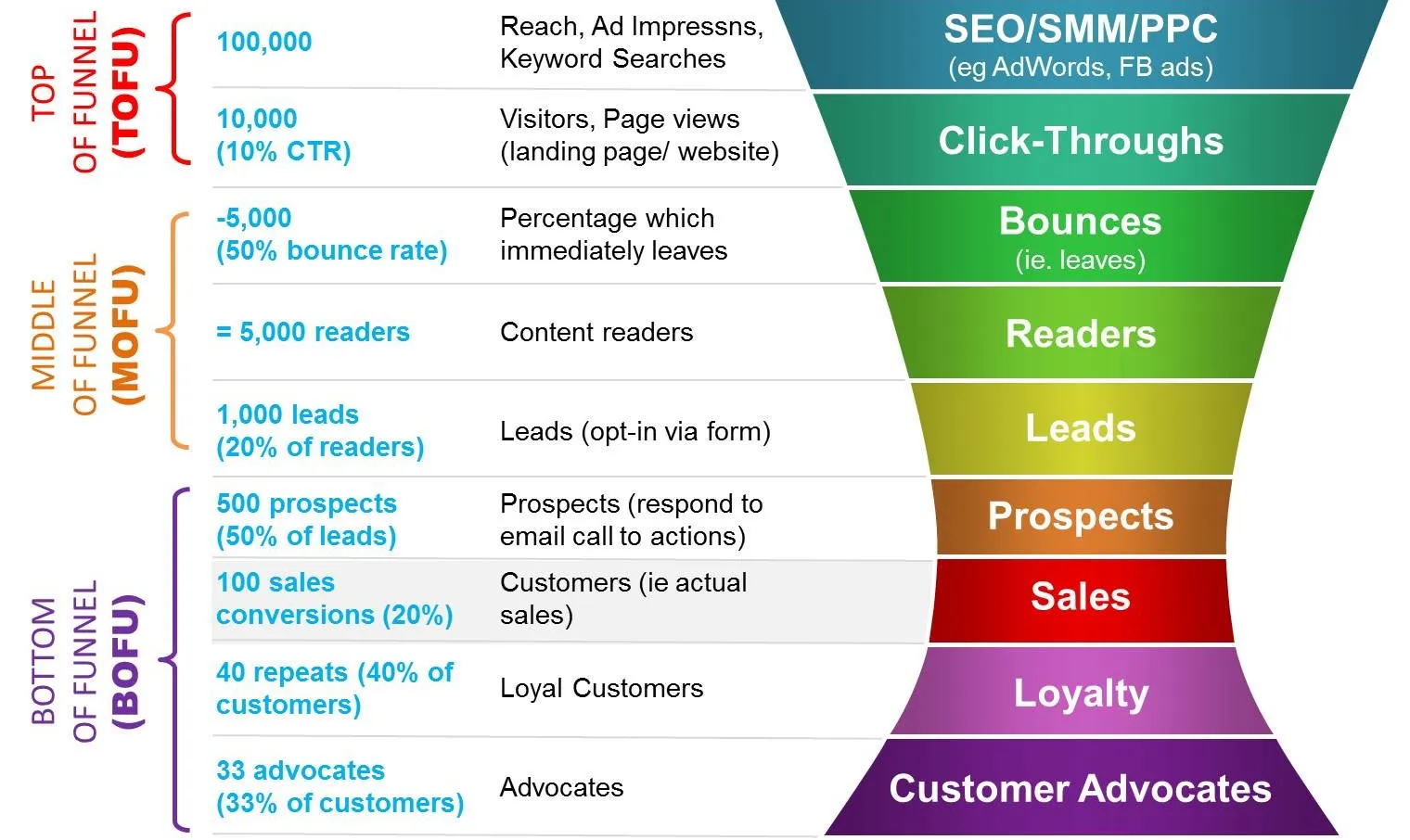
Measuring the performance of your marketing funnel is crucial for understanding the effectiveness of your marketing strategies and for making data-driven decisions.
Here's a breakdown of key performance indicators (KPIs) for each stage of the marketing funnel, highlighting their importance and how they can be leveraged for optimization.
- Traffic Volume: The total number of visitors to your website or landing page. A high volume indicates strong brand visibility and reach.
- Social Media Reach and Engagement: Measures the spread of your social media content and how actively involved your audience is. High engagement rates often correlate with increased brand awareness.
- Impressions and Click-Through Rate (CTR) on Paid Ads: The number of times your ads are viewed and the percentage of clicks on those ads. These metrics gauge the effectiveness of your advertising efforts in attracting attention.
- Lead Generation Rate: The percentage of visitors who become leads by taking a specific action, such as filling out a contact form. It reflects the effectiveness of your lead magnets and CTAs.
- Email Open and Click-Through Rates: The percentage of recipients who open your emails and click on links within those emails. These metrics indicate how compelling and relevant your content is to the audience.
- Conversion Rate: The percentage of leads that make a purchase. It’s a direct indicator of how effectively your funnel is moving leads to the decision stage and converting them into customers.
- Average Order Value (AOV): The average amount spent by customers per transaction. Increasing AOV can significantly impact your revenue, even without increasing the number of customers.
- Customer Retention Rate: The percentage of customers who make repeat purchases. High retention rates indicate satisfied customers and a strong value proposition.
- Net Promoter Score (NPS): A measure of customer satisfaction and loyalty. It indicates the likelihood of customers recommending your brand to others, which can lead to organic growth through word-of-mouth.
- Referral Rate: The percentage of customers who refer your product or service to others. High referral rates suggest strong customer satisfaction and advocacy.
- User-Generated Content (UGC) Volume: The amount of content created by your customers related to your brand, such as reviews, testimonials, or social media posts. UGC can enhance credibility and attract new customers.
- Customer Lifetime Value (CLV): The total revenue you can expect from a single customer throughout their relationship with your brand. CLV helps you determine how much you should invest in acquiring new customers and retaining existing ones.
- Cost Per Acquisition (CPA): The total cost of acquiring a new customer. Balancing CPA with CLV is essential for ensuring the profitability of your marketing efforts.
Final Thoughts on Building Marketing Funnels
Building a successful marketing funnel is all about understanding what your customers need and making sure you’re there to offer it at every step of their journey. Start by grabbing their attention with interesting content that shows up where they already spend time online. Then, keep them interested by offering more detailed information and helpful solutions to their problems.
When they’re ready to buy, make the process easy and straightforward. And don’t stop there—keep in touch with great after-sales service and rewards that make them want to come back and even tell their friends about you.
The key is to always be improving based on what works and what your customers want. Use technology to make things smoother and always aim to deliver value. This way, your marketing funnel will not only help you sell more but also build strong, lasting relationships with your customers.
Future Reading
Ready to take your marketing efforts to the next level and build a highly successful marketing funnel? Explore these insightful articles from Aloré's blog to gain deeper insights and refine your marketing strategies:
- Mastering Lead Generation: Dive into effective lead generation techniques to attract, capture, and nurture leads throughout your marketing funnel. Learn how to optimize lead generation strategies to fuel your sales pipeline and drive sustainable growth. Read more
- Personalization in Email Marketing: Explore the power of personalized marketing to engage prospects and customers at every touchpoint along your funnel. Learn how to leverage data-driven personalization techniques to deliver relevant content, offers, and experiences that resonate with your audience. Read more
- Maximizing Social Media Engagement: Unlock the potential of social media to amplify your marketing funnel. Discover strategies for leveraging various social platforms to build brand awareness, foster community engagement, and drive traffic to your funnel. Read more
- B2B Email Marketing: Learn how to leverage email marketing effectively throughout your marketing funnel. Explore best practices for crafting compelling emails, segmenting your audience, and automating campaigns to nurture leads and drive conversions. Read more
- Marketing Automation: Stay ahead of the curve by exploring the future of marketing automation technologies. Learn how AI, machine learning, and automation tools are reshaping marketing processes and revolutionizing the way businesses engage with customers throughout the funnel. Read more
Dive into these resources to supercharge your marketing funnel and drive meaningful results for your business.

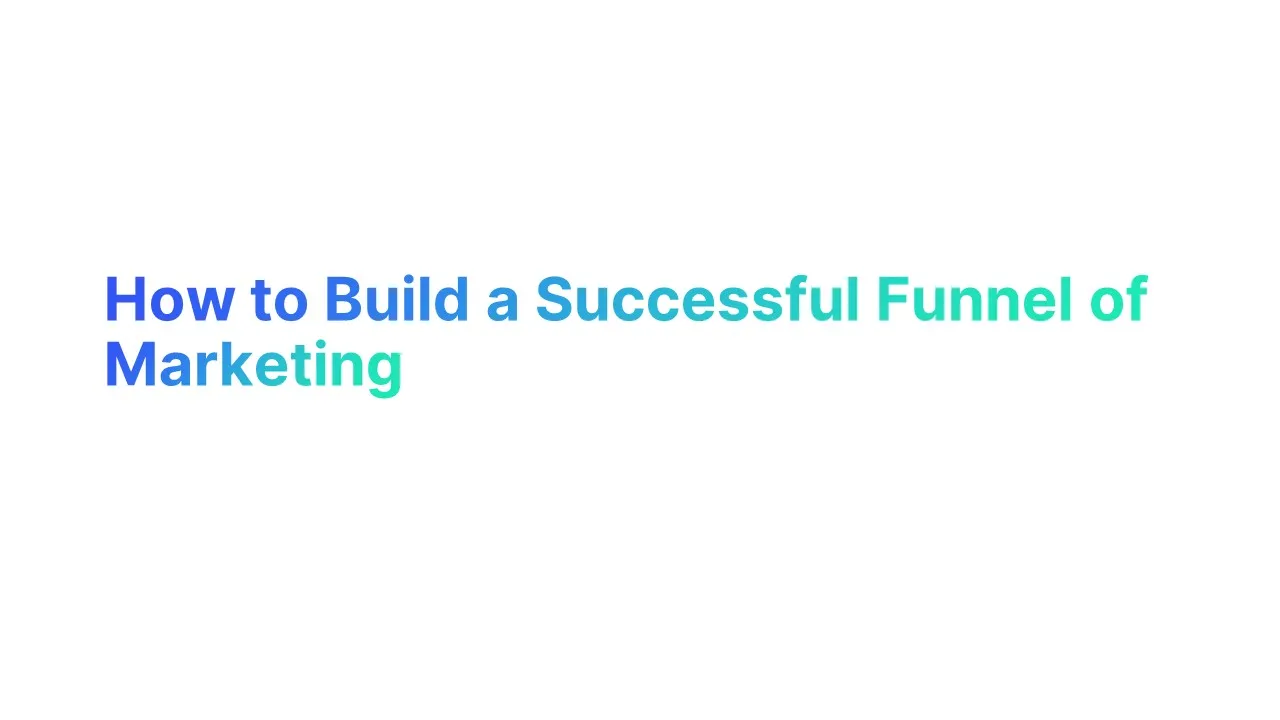



.jpg)

.jpg)
